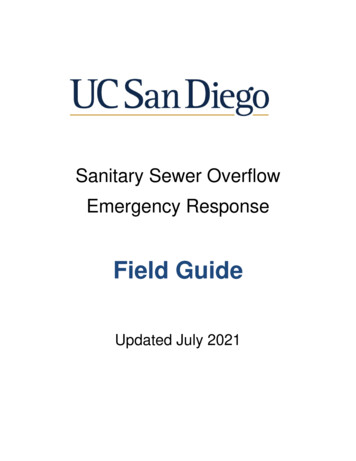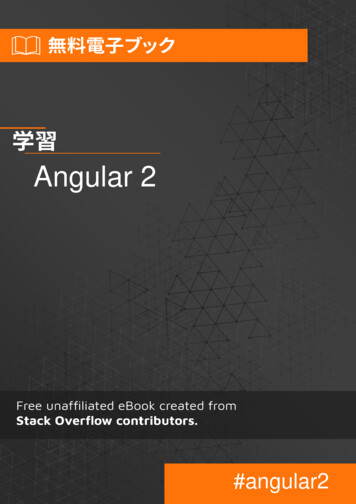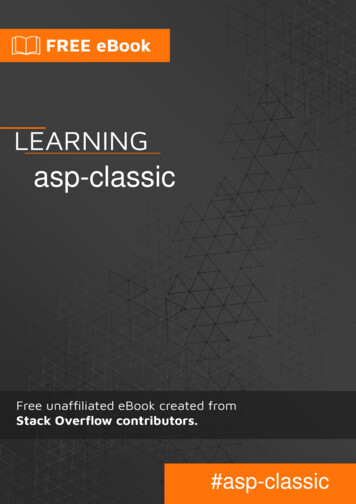
Transcription
Sanitary Sewer OverflowEmergency ResponseField GuideUpdated July 2021
Overflow Notification ProceduresWhen an overflow is detected:8:00 am to 4:00 pm, Monday- Friday:Notify EH&S for all spills at858-534-3660After hours: Call 858-534-HELP (4357)and Police Dispatch will alert properafter- hours respondersImmediatelynotify propersupervisorDetermine extent of spillsee definitions on page 8Category 1 SSOs thatare 1,000 gallons orgreater that result in adischarge to a surfacewater, and Category 1SSOs that are 1,000gallons or greater thatresult in a discharge to,and are not fullyrecovered from, a stormdrainSpilloccurswherepubliccontactis likelyNotify the California Office ofEmergency Services (OES) at800-852-7550 within the first 2 hoursContinue withCategory 1 spillprotocol.†CaliforniaIntegrated Water Quality System – If CIWQSis not available, you must FAX to San Diego RegionalWater Quality Control Board: Fax 619-516-1994If you have any questions about the contents of thisOERP Field Guide, please contact Sam Petersen at(858) 583-3298 or sjpetersen@ucsd.eduUC San DiegoOverflow Emergency Response Field GuideCategory 1andCategory 2SSOsDraft reportsshall besubmitted to theCIWQS OnlineSSO Databasewithin 3business daysof becomingaware of theSSOFinal reportsshall be certifiedthrough theCIWQS OnlineSSO Databasewithin 15calendar daysthe end date ofthe SSOCategory 3SSOs andall otherspillsSSOs thathave50,000gallons orgreaterspilled tosurfacewatersEnter anelectroniccertifiedreport toCIWQS† within30 calendardays from theend of themonth in whichthe spilloccurredEnter anSSOTechnicalReport toCIWQSwithin 45calendardays ofthe SSOend dateAPPENDIX C-2
UCSD SSO Report FormLocation of Spill:Exact Latitude:(6 decimal points)What DAY and TIMEwas FM notified?Exact Longitude:(6 decimal points)What DAY and TIME didFM arrive on scene?SPILL START DATE (MM/DD/YY)SPILL START TIME (AM / PM)SPILL END DATE (MM/DD/YY)SPILL END TIME (AM / PM)What day and time was the SSO Cleared?Who initially reported the spill?Report NA if information is not available(Name)Who is filling out this SSO Report Form?(Name)Estimated Spill Volume(gal)(Number)Estimated Spill Rate(Number)(gal/min)Estimated Volume of Spill Recovered(gal)Spill Dimensions:Were photos taken?What method(s) were used to estimate spill volume? (Circle all that apply)Eyeball MethodCalculations from Spill DimensionsDuration and Flow RateDrop Bucket MethodCalculations Based on Pipe SizeFlow from Vent or Pick HolesOpen Channel Spill EstimationFlow around Manhole CoverFlow from Manhole w/o a CoverRefer to Volume Estimation forms to document spill dimensions, shapes and other information.Did the spill reach a storm drain system? YESEstimated spill discharged tostorm drain system (gal)NOEstimated spill volume recoveredfrom discharge to storm drainsystem (gal)Did the spill discharge to surface waters? YESEstimated spill dischargedto surface waters (gal)Did the spill discharge to land?Estimated spill discharged to land(including building/structures)(gal)NOEstimated spill volume recoveredfrom surface waters (gal)YESNOEstimated spill volume recovered from dischargeto land (do not include water for clean-up) (gal)Final SpillPaved Surface Building / StructureDestination(Circle allBeachStreet / Curb / Gutterthat apply):Cause of Spill (options on back):Unpaved SurfaceOther:Where are the spill appearance points? (options on back):Where did the failure occur? (options on back):Complete both sides of formStorm DrainSurface Water
UCSD SSO Report FormSpill Response Activities (circle all that apply):Cleaned upContained all or portion of spillInspected sewer using CCTVRestored FlowReturned all or portion of spill to sanitary sewersystemMitigated Effects of SpillProperty Owner NotifiedOther Enforcement Agency NotifiedOther:Spill Corrective Actions Taken (circle all that apply):Added Sewer to Preventative Maintenance ProgramAdjusted Schedule / Method of Preventative MaintenanceEnforcement Action Against FOG SourceInspected Sewer Using CCTVPlan rehabilitation or replacement of sewerRepaired Facilities or Replaced DefectOther:Cause of spill:Air relief valve (ARV) FailureBlow-off Valve (BOV) FailureConstruction Diversion FailureCS Maintenance Caused Spill/ DamageDamage by others not related to CSConstruction/ Maintenance (specify type below)Debris from ConstructionDebris from LateralDebris-GeneralDebris- RagsFlow exceeded capacity (Separate CS only)Grease Deposition (FOG)Inappropriate discharge to CSNatural DisasterNon-DispersiblesOperator ErrorOther (specify)Pipe Structural Problem/ Failure InstallationPump Station Failure- ControlsPump Station Failure- MechanicalPump station Failure- LowerRainfall Exceeded Design, I and I (Separate CSOnly)Root IntrusionSiphon FailureSurcharged Pipe (Combined CS Only)VandalismSpill Appearance Point (circle all that apply):Force MainGravity MainlineInside Building or StructureLateral Clean-OutLower LateralManholeOther Sewer System StructurePump StationUpper LateralWhere did failure occur:Air relief valve (ARV)Blow- off Valve (BOV)Force MainGravity MainlineLower Lateral (Public)ManholeOther (specify below)Pump Station- ControlsPump Station- MechanicalPump Station- PowerSiphonUpper Lateral (public)Work Order Numbers:Additional Notes and DocumentationComplete both sides of form
Overflow Emergency Response PlanDispatch ResponsibilityWhen a call is received from the public, dispatch personnel obtain: Time and date of call Specific location of possible overflow Description of problem Caller’s name and call back numberFirst Responder Assessment of OverflowAlways Remember Use appropriate Personal Protective EquipmentUse appropriate safety precautionary measuresWhen?Assessment StepsImmediatelyAssess failure of equipment or overflowreleaseImmediatelyAssess if overflow left UC San DiegopropertyIf neededCall for assistanceAfter primary assessmentObtain necessary equipment to respondto spill (e.g. sandbags, waddles, bypasspumps, emergency generators, etc.)If spill too large to be adequatelycontrolledCall outside contractorIf there is a suspicious substance (e.g.oil sheen, foam)Coordinate with UCSD EH&Shazardous materials responseIf there is a suspicious odor (e.g.gasoline)Coordinate with UCSD EH&Shazardous materials response
Overflow Correction, Containment, and Clean-upAlways Protect water bodies and storm drains bydiverting flow away from streets andpaved areasDetermine location and cause of overflowImplement appropriate corrective actions(e.g. sandbags, waddles, emergencygenerators, bypass pumps, etc.)Clean and sanitize affected area(s)Finalize the incident documentationReview overall response with RespondingPartiesIf applicable If failure is at a lift station, take themalfunctioning pump off lineSecure the affected area and postwarning signs (also see “Traffic andCrowd Control” below)Sample as necessary (coordinate with theSan Diego County DepartmentEnvironmental Health Services)**Sampling methodology needs to be consistent with the requirements outlined in theSSO Sampling ProtocolTraffic and Crowd ControlIf spill happens in an area with a public access road or where the spill may come intocontact with the public:Traffic/ Crowd Control Recommendations Set up cones and warning signs Set up warning signs to inform public of hazards Close affected entrances and exits from facilities Perform lane closures as necessary Use caution tape and barricades to prevent public access Inform UCSD Police of any law enforcement necessary for roadway closures/traffic controlUC San DiegoOverflow Emergency Response Field GuideAPPENDIX C-6
Emergency Contact ListAgency/ OfficialAgencyContactUCSDEnvironment,Health, and Safety858-534-3660Any sewage spillImmediately800-852-7550Or916-845-8911Category 1 SSOs thatare 1,000 gallons orgreater that result in adischarge to a surfacewater, and Category 1SSOs that are 1,000gallons or greaterthat result in adischarge to, and arenot fully recoveredfrom, a storm drainWithin 2 hours ofdetectionSewage spill enteredwaterway(s)As soon aspracticable858-637-5581Violation of dischargeprohibitionAs soon aspracticable858-495-5579Violation of dischargeprohibitionAs soon aspracticableCalifornia Office ofEmergencyServices (OES)CaliforniaDepartment ofFish and WildlifeRegional WaterQuality ControlBoardSan Diego CountyDepartment ofEnvironmentalHealth and Quality858-467-4201Reason(s) to NotifyWhen to NotifyContractor List for Additional ResponseUSA Jetting(619) 666-0666Affordable Pipeline Services(858) 689-4000NRC Environmental Services(800) 337-7455Clean Harbors Environmental, Inc.(800) 645-8265Atlas Pumping(800) 491-7867Badger Daylighting(619) 791-9423UC San DiegoOverflow Emergency Response Field GuideAPPENDIX C-7
SSO Category DefinitionsCategory 1- Discharges of untreated or partially treated wastewater of any volumeresulting from an enrollee’s sanitary sewer system failure or flow condition that:a. Reach surface water and/ or reach a drainage channel tributary to a surfacewater; orb. Reach an MS4 (Storm Drain System) and are not fully captured and returned tothe sanitary sewer system or not otherwise captured and disposed of properly.Any volume of wastewater not recovered from the MS4 is considered to havereached surface water unless the storm drain system discharges to a dedicatedstorm water or groundwater infiltration basin (e.g., infiltration pit, percolationpond).Category 2- Discharges of untreated or partially treated wastewater greater than orequal to 1,000 gallons resulting from an enrollee’s sanitary sewer system failure or flowcondition that does not reach a surface water, a drainage channel, or the MS4 (if theentire SSO volume discharged to the storm drain system is fully recovered anddisposed of properly, then a Category 3).Category 3- All other discharges of untreated or partially treated waste water resultingfrom an enrollee’s sanitary sewer system failure or flow condition.UC San DiegoOverflow Emergency Response Field GuideAPPENDIX C-8
Water Quality Monitoring RequirementsThe SSO Water Quality Monitoring Program is meant to assess impacts from SSOs tosurface waters in which 50,000 gallons or greater are spilled into surface waters. Utilize SSO Sampling Protocol shown below* When sampling account for spill travel time in the surface water. All samples being tested for indicators are to be analyzed in an accredited orcertified laboratory. When analyzing samples, only use monitoring instruments and devices that havebeen properly maintained and calibrated. Within 48 hours of the enrollee becoming aware of the SSO, water qualitysampling must, at a minimum, test for ammonia and appropriate bacterialindicators.SSO Sampling Protocol*For SSOs that reach surface waters, monitoring and testing activities may include: Obtaining water quality samples. Gathering samples upstream and downstream of any location where SSOreached surface water. Logging the sample location, time, and water temperature on the chain ofcustody form. Creating a map of the sample locations so that follow-up testing can beperformed. Collecting samples at the location where the SSO entered the water. Whentaking the sample, submerge the bottle below the surface of the water with thecap on. Once the bottle is under the surface, remove the cap and fill the bottle.Gloves should be worn while sampling to avoid infecting any open wounds. Analyzing the sample for at least the following constituents:o Ammonia Nitrogen;o Biochemical Oxygen Demand (BOD);o Dissolved Oxygen (DO);o Enterococci, Total Fecal Coliform;o Total Suspended Solids (TSS); ando Additional sampling requirements as imposed by the SDRWQCB (couldinclude VSS, pH, turbidity, Oil & Grease, etc.)*Sampling protocol taken from SD County SSMP and CA SWRCB websiteUC San DiegoOverflow Emergency Response Field GuideAPPENDIX C-9
Estimating Spill VolumeMethods:1) Eyeball Estimate and Kick Bucket MethodBest for small spills 100 gallons or less, that can be visually approximated2) Estimating Volume Based on Spill DimensionsLarger spills that are no longer flowing and can be measured3) Duration and Flow RateGood for large spills where dimensions cannot be measured, but the flowrate can be calculated4) Open Channel Spill EstimationGood for large flowing spills where dimensions cannot be measured, but theflow rate can be calculated5) Drop Bucket MethodBest for small flowing spills where the entire flow can be captured in a bucket6) Calculating Spill Volume Based on Pipe SizeBest for spills where pipe and flow information is known7) Determine Spill Volume From Vent or Pick HolesBest for spills originating from vent or pick holes in the ground/ manhole8) Determine the Volume of a Spill from Around the Rim of a Manhole CoverBest for spills originating from a manhole with a cover9) Determine the Volume of a Spill from a Manhole without a CoverBest for spills originating from a manhole without a coverUC San DiegoOverflow Emergency Response Field GuideAPPENDIX C-10
Method 1: Eyeball neerpdf/SewerSystemMgtPlan Jun2010.pdf) Imagine amount of water that would spill from bucket or barrelBucket 5 gal, barrel 50 galThis method is only useful for spills up to 100 gal Kick Bucket .pdf)o Can be used to estimate the volume of spills on asphalt, concrete, slopedsurfaces, and flat surfaces.o One gallon spill on a sloped surface. (left: spill only, right: spill with a pointof reference)o Two gallon vs. one gallon spill on a slope (two gallons left, one gallonright).UC San DiegoOverflow Emergency Response Field GuideAPPENDIX C-11
o Two gallon spill on a very slight slope.o Five gallon spill- forty feet in length.UC San DiegoOverflow Emergency Response Field GuideAPPENDIX C-12
Method 1: Eyeball Method and Kick the Bucket Volume Measurement WorksheetManhole/ Pipe Number:Date:Name of Estimator:Telephone:Exact Location of Spill (address):Exact Latitude:Exact Longitude:Picture taken?YESNODimensions of spill (in ft. or paces): LengthWidthShape of spill:TRIANGLERECTANGLEEstimated spill volume:One gallon on sloped surfaceDepthCIRCLEgalTwo gallon spill on sloped surfaceEstimated volume of spill recovered:Five gallon spill on sloped surfacegalPlease sketch spill with dimensions:Was the measurement tested?Was a reference image used?YESYESNONOAdditional Notes and Documentation (please describe how the spill volume wascalculated/ measured.):UC San DiegoOverflow Emergency Response Field GuideAPPENDIX C-13
Method 2: Estimating Volume Based on Spill gineerpdf/SewerSystemMgtPlan Jun2010.pdf) If not raining, the shape, dimensions, and depth of spill may be used to estimatevolume1. Sketch shape of spill2. Measure/pace off dimensions3. Measure depth in several locations; take average4. Convert all dimensions to feet5. Calculate area of spill based on approximate shape: Rectangle: Area length x width Circle: Area diameter x diameter x 0.785 Triangle: Area base x height x 0.56. Multiply area x depth to get volume7. Multiply volume x 7.5 to convert into gallons Using a spill footprint to get surface area and sample sketch Calculate average depth to get a depth measurementUC San DiegoOverflow Emergency Response Field GuideAPPENDIX C-14
Method 2: Spill Volume Estimation Worksheet Based on Spill DimensionsManhole/ Pipe Number:Date:Name of Estimator:Telephone:Exact Location of Spill (address):Exact Latitude:Exact Longitude:Picture taken?Shape of spill:YESNORECTANGLETRIANGLECIRCLEPlease sketch spill in zones with dimensions:Area # 1 % WetArea # 2 % WetArea # 3 % WetArea # 4 % WetArea # 5 % WetArea # 6 % WetPlease Calculate Average Depth:Estimated Spill Surface Area square feetNumber of Depth Measurements Used Average Depth inchesEstimated Spill Volume: galEstimated volume of spill recovered:galAdditional Notes and Documentation (please describe how the spill volume wascalculated/ measured. Please show calculations.):UC San DiegoOverflow Emergency Response Field GuideAPPENDIX C-15
Method 3: Duration and Flow pdf/SewerSystemMgtPlan ?id 12868) If area/ depth is impossible to measure, use duration and flow rate estimateDuration: time elapsed from start to end of SSO To estimate start time, use one of the following methods:1. Compare hourly data on a downstream flow meter to find changes in flow.Typically the daily flow peaks are flattened by the loss of flow.2. Observe conditions at the SSO site. Initially there will be limited depositsof grease and toilet paper. After a few days to a week, the grease forms alight colored residue. After a few weeks to a month the grease turns dark.In both cases the quantity of toilet paper and other materials of sewageorigin increase in amount. These changes with time can be used toestimate the start time in the absence of other information. To estimate end time, observe the “blow down” that occurs when blockage isremoved or observe “blow down” on flow meters.Flow Rate: average flow left in sewer system during time SSO stopped,estimated using one of the following three ways:1. Use data from flow meter to estimate flow rate for the spill (better forlarge SSOs).2. Estimate based on up-stream connections. Once the location of the SSOis known, the number of upstream connections can be determined fromsystem maps. Multiply the number of connections by 200 to 250 gallonsper day per connection, or 8 to 10 gallons per hour per connection, orother flow rates that are consistent with the City’s data for its connections. Example: 22 upstream connections x 9 gallons per hour perconnection 198 gallons per hour / 60 minutes per hour 3.3gallons per minute. Multiply the gallons per minute times thenumber of minutes the spill occurred for the total volume of the spill.3. Refer to the Reference Sheet for Estimating Sewer Spills to estimateflow rate based on images obtained from tests below. Volume of SSO is the product of the duration (in hours or days) x flow rate (ingallons per hour or gallons per day). (ft3 7.48 gal)UC San DiegoOverflow Emergency Response Field GuideAPPENDIX C-16
UC San DiegoOverflow Emergency Response Field GuideAPPENDIX C-17
Method 3: Spill Volume Estimation Based on Duration and Flow RateManhole/ Pipe Number:Date:Name of Estimator:Telephone:Exact Location of Spill (address):Exact Latitude:Exact Longitude:Estimated spill start date/time:(MM/DD/YY) (HR:MIN)Estimated spill end date/time:(MM/DD/YY) (HR:MIN)Spill duration:minFlow rate:gal/minHow was flow rate determined?Flow MeterUpstream ConnectionsEstimated spill volume (duration x flow rate):Estimated volume of spill recovered:Picture taken?YESReference SheetgalgalNODimensions of spill (in ft. or paces): LengthWidthShape of spill:TRIANGLERECTANGLEDepthCIRCLEPlease Sketch Spill with Dimensions:Additional Notes and Documentation (please describe how the spill volume wascalculated/ measured. Please show calculations.):UC San DiegoOverflow Emergency Response Field GuideAPPENDIX C-18
Method 4: Open Channel Spill d 12868) For ditches, channels, gutters, etc.1. Measure the cross sectional dimensions (to determine the area) of thechannel and determine the velocity of the flow.2. Velocity can be measured by dropping a floating object into the flow andtiming the object over a measured distance.3. Flow (Q), ft3/sec Velocity (V), ft/sec X Area (A),ft24. Flow times duration equals amount of spill5. Multiply by 7.48 (number of gallons in one cubic foot) to convert to gallonsUC San DiegoOverflow Emergency Response Field GuideAPPENDIX C-19
Method 4: Spill Volume Estimation Based on Open Channel SpillsManhole/ Pipe Number:Date:Name of Estimator:Telephone:Exact Location of Spill (address):Exact Latitude:Exact Longitude:Estimated spill start date/time:(MM/DD/YY) (HR:MIN)Estimated spill end date/time:(MM/DD/YY) (HR:MIN)Spill duration:minVelocity:Cross Sectional Area of Ditch, Channel, or Gutter:Depth:ft.Width:ft.Flow rate (velocity x Area):Area:ft./minft2ft3/minEstimated spill volume (duration x flow rate x 7.48):galEstimated volume of spill recovered:galPicture taken?YESNODimensions of spill (in ft. or paces): LengthWidthShape of spill:TRIANGLERECTANGLEDepthCIRCLEPlease Sketch Spill with Dimensions:Additional Notes and Documentation (please describe how the spill volume wascalculated/ measured. Please show calculations.):UC San DiegoOverflow Emergency Response Field GuideAPPENDIX C-20
Method 5: Drop Bucket Method(http://www.ocsd.com/Home/ShowDocument?id 12868) Can be used for small spills where the entire flow stream can be captured in abucket.1. Place bucket so that it captures the entire flow stream and time how long ittakes to fill the bucket.2. Dividing the volume of the bucket (in gallons) by the elapsed time to fill thebucket (in minutes) equals the flow rate in gallons per minute (gpm). Example: If it takes 30 seconds to fill a 5-gallon bucket and the spillhas occurred for 20 minutes the total spill volume would be 200gallons (5gal/.5min 10gpm X20min 200gal).UC San DiegoOverflow Emergency Response Field GuideAPPENDIX C-21
Method 5: Spill Volume Estimation Based on Drop Bucket MethodManhole/ Pipe Number:Date:Name of Estimator:Telephone:Exact Location of Spill (address):Exact Latitude:Exact Longitude:Volume of bucket used to determine volume:galTime needed for flow to fill bucket:minFlow rate:gal/minSpill duration:minEstimated spill volume (duration x flow rate):Estimated volume of spill recovered:Picture taken?YESgalgalNODimensions of spill (in ft. or paces): LengthWidthShape of spill:TRIANGLERECTANGLEDepthCIRCLEPlease Sketch Spill with Dimensions:Additional Notes and Documentation (please describe how the spill volume wascalculated/ measured. Please show calculations.):UC San DiegoOverflow Emergency Response Field GuideAPPENDIX C-22
Method 6: Calculating Spill Volume Based on Pipe Size(http://www.ocsd.com/Home/ShowDocument?id 12868) Volume of a spill can be measured using the flow rate in a pipe before and afterthe blockage is clear.1. Need to know the size of the pipe2. Need a flow calculation chart3. Measure the depth of the flow down- stream of the blockage4. Measure the depth of flow again after the blockage has been cleared andflow stabilized5. Use flow calculation chart to determine the flow rate of the pipe Example: A Spill was reported at 3:50 pm and was corrected at 6:25 pm on thesame day. Calculate the volume of the spill for a 10 inch pipeline with 1 inch ofdownstream flow before correction and 5 inches of flow after correction andstabilization of flow.Time reported – 3:50 pmTime Corrected – 6:25 pmUC San DiegoOverflow Emergency Response Field GuideAPPENDIX C-23
Duration of spill – 2:35 or 155 minutesDepth of flow before – 1 inchDepth of flow after – 5 inchesFrom Chart:Flow after stabilization 240 gpmFlow downstream before 25 gpmNet Flow 240 -25 215 gpmSPILL VOLUME 215 (gpm) X 155 (m) 33,325 gallonsUC San DiegoOverflow Emergency Response Field GuideAPPENDIX C-24
Method 6: Spill Volume Estimation Based on Pipe SizeManhole/ Pipe Number:Date:Name of Estimator:Telephone:Exact Location of Spill (address):Exact Latitude:Exact Longitude:Estimated spill start date/time: (MM/DD/YY) (HR:MIN)Estimated spill end date/time: (MM/DD/YY) (HR:MIN)Spill duration:minPipe size:inchesDepth of flow before correction:Depth of flow after correction:inchesinchesFlow before stabilization (from chart):Flow after stabilization (from chart):Net flow (after- before stabilization):gpmgpmgpmEstimated spill volume (duration x net flow):galEstimated volume of spill recovered:galPicture taken?YESNODimensions of spill (in ft. or paces): LengthShape of spill:RECTANGLEWidthTRIANGLEDepthCIRCLEAdditional Notes and Documentation (please describe how the spill volume was calculated/measured. Please show calculations.):UC San DiegoOverflow Emergency Response Field GuideAPPENDIX C-25
Method 7: Determine Spill Volume from Vent or Pick Holes(http://www.ocsd.com/Home/ShowDocument?id 12868) If spill is coming from vent or pick holes:1. Count the number of holes2. Measure the height of the water exiting from the holes3. Refer to pick hole chart to determine the volume from each hole (below)4. Multiply the number of holes times the flow rate times the duration of thespill to determine spill volumeUC San DiegoOverflow Emergency Response Field GuideAPPENDIX C-26
Method 7: Spill Volume Estimation Based on Spill from Vent or Pick HolesManhole/ Pipe Number:Date:Name of Estimator:Telephone:Exact Location of Spill (address):Exact Latitude:Exact Longitude:Estimated spill start date/time:(MM/DD/YY) (HR:MIN)Estimated spill end date/time:(MM/DD/YY) (HR:MIN)Spill duration:minNumber of Pick of Vent Holes:Size of Pick or Vent Holes (diameter):inchesHeight of water exiting pick or vent holes:inchesUC San DiegoOverflow Emergency Response Field GuideAPPENDIX C-27
Flow rate from each hole (chart):gal/minEstimated spill volume (duration x flow rate x number of holes):Estimated volume of spill recovered:galPicture taken?YESNODimensions of spill (in ft. or paces): LengthWidthShape of spill:TRIANGLERECTANGLEgalDepthCIRCLEPlease Sketch Spill with Dimensions:Additional Notes and Documentation (please describe how the spill volume wascalculated/ measured. Please show calculations.):UC San DiegoOverflow Emergency Response Field GuideAPPENDIX C-28
Method 8: Determine the Volume of a Spill from Around the Rim of a ManholeCover (http://www.ocsd.com/Home/ShowDocument?id 12868) If manhole cover is in place:1. Find the area of the gap (diameter of the cover from the diameter of theinside of the ring)2. Find the velocity (ft/sec) of the spill by measuring the height of the sewageplume3. Area times the velocity (ft/sec) times the duration of the spill times (448.8for gpm/cfs) equals the total spill volume in gallonsUC San DiegoOverflow Emergency Response Field GuideAPPENDIX C-29
Method 8: Spill Volume Estimation Based on Spill Around the Rim of a ManholeCover that is in PlaceManhole/ Pipe Number:Date:Name of Estimator:Telephone:Exact Location of Spill (address):Exact Latitude:Exact Longitude:Estimated spill start date/time:(MM/DD/YY) (HR:MIN)Estimated spill end date/time:(MM/DD/YY) (HR:MIN)Spill duration:minArea of gap (diameter of the cover from the diameter of the inside ring):Height of sewage plume:inchesVelocity (chart):ft./secft2Estimated spill volume (duration min x velocity ft./sec x area ft2 x 448.8 gpm/cfs):galEstimated volume of spill recovered:Picture taken?YESWas reference photo used?YESDimensions of spill (in ft. or paces): LengthShape of se Sketch Spill with Dimensions:Additional Notes and Documentation (please describe how the spill volume wascalculated/ measured. Please show calculations.):UC San DiegoOverflow Emergency Response Field GuideAPPENDIX C-30
Method 9: Determine the Volume of a Spill from a Manhole without a Cover(http://www.ocsd.com/Home/ShowDocument?id 12868) If manhole cover is not in place:1. Find the area of the manhole opening (Area 3.14 R2)2. Find the velocity (ft/sec) of the spill by measuring the height of the sewageplume3. Area times the velocity (ft/sec) times the duration of the spill times (448.8gpm/cfs) equals the total spill volume in gallons.UC San DiegoOverflow Emergency Response Field GuideAPPENDIX C-31
Method 9: Spill Volume Estimation Based on Spill from a Manhole without aCoverManhole/ Pipe Number:Date:Name of Estimator:Telephone:Exact Location of Spill (address):Exact Latitude:Exact Longitude:Estimated spill start date/time:(MM/DD/YY) (HR:MIN)Estimated spill end date/time:(MM/DD/YY) (HR:MIN)Spill duration:minArea of manhole opening (A 3.14 r 2):ft2Height of sewage plume:inchesVelocity (chart):ft./secEstimated spill volume (duration min x velocity ft./sec x area ft2 x 448.8 gpm/cfs):galEstimated volume of spill recovered:Picture taken?YESWas reference photo used?YESDimensions of spill (in ft. or paces): LengthShape of se Sketch Spill with Dimensions:Additional Notes and Documentation (please describe how the spill volume wascalculated/ measured. Please show calculations.):UC San DiegoOverflow Emergency Response Field GuideAPPENDIX C-32
UC San Diego Overflow Emergency Response Field Guide APPENDIX C-2 Overflow Notification Procedures . When an overflow is detected: Category 1. and . where Category 2. public . contact. 8:00 am to 4:00 pm, Monday- Friday: Notify EH&S for all spills at . Coordinate with UCSD EH&S










